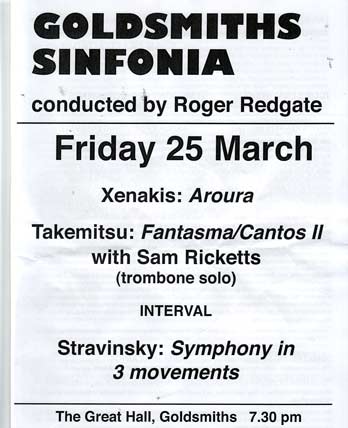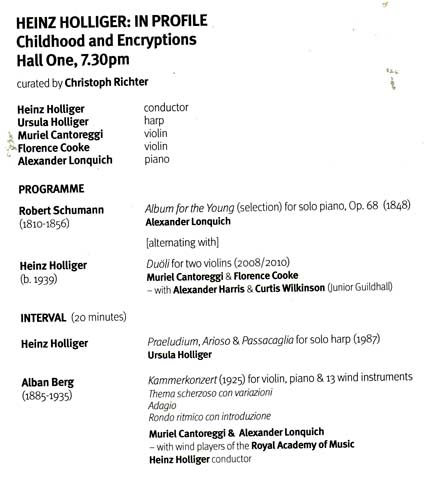Xenakis, Takemitsu & Stravinsky

Takemitsu's lyrical concerto for solo trombone Fantasma/Cantos 2 was one of Takemitsu's last compositions, possibly inspired in part by the composer's reminiscences of hearing Jack Teagarden in his youth although these influences are thoughtfully distilled into his own familiar language. Takemitsu was terminally ill by this time yet this work comes across as one of his lighter expressions, the central cadenza for the soloist particularly effective in its use of wide-ranging effects. It was almost indecently beautiful, and a very welcome reminder of an important voice in 20 C music.
Xenakis' Aurora for twelve strings is one of his less often played computer-composed works (1971), dominated by group glissandi (anticipating Gloria Coates much later). It made a splendid impression on a full string orchestra of Goldsmiths students, whose chief study remits are academic, but they regularly give fine performances on their chosen instruments.
It was good that they had an opportunity to study Stravinsky's wartime symphony (1943-45) even though it overstretched their collective capability somewhat.
Nonethless, the whole concert was a rewarding one, and Goldsmiths Great Hall at New Cross is one of the better venues in London for hearing medium sized orchestral music.
Peter Grahame Woolf
|
|
Holliger, Schumannn & Berg
In prospect an attractive evening, especially with it preceded by an illustrated lecture analysis of the Berg concerto, which Holliger admires as one of the greatest peaks of 20 C music.
Holliger on Alban Berg's Kammerkonzert
This lecture event was a disaster, given without any help on screen, rather like an earnest pre-TV radio programme mid-20 C. It was expensive to attend and few of the mere thirty people who came would have been able to follow the numerolgy of themes (forwards and backwards) given with German nomenclature for the notes, and other recondite allusions to works by Schonberg, Berg and Webern, and (recently decoded) the initials of Schoenberg's wife too. Probably of the audience, only one member of the critical fraternity could keep up, following the argument on his miniature score in the darkened Hall One which is nowadays de rigeur...
Hopefully, Heinz Holliger will go on to expand this talk into a viable video-lecture on DVD? (Watching next day Michael Tilson Thomas, on a Sky TV documentay introducing Ives Holiday Symphony, emphasised the huge gulf between Holliger's teaching style and what today's audiences expect!)
The concert itself was overlong, finishing late with a determined but unsubtle account of the Concerto, exhausting for all concerned (hear a more lucid account of it under Boulez).
Holliger's little violin duos, progressive teaching pieces after the model of Bartok's etc, were introduced individually in both Swiss-German and English,extending the session therby... They were well put over by two accomplished youngsters (who had probably been playing violin for five or six years already) and two adults who took on the more demanding ones.
They were interspersed with some of Schumann's Album for the Young; those would better have been entrusted to young Junior Exhibitoner pianists from the colleges? A smaller selection of them (they took up the whole frst half of the concert) would have made for a better balanced evening.
Peter Grahame Woolf
|



